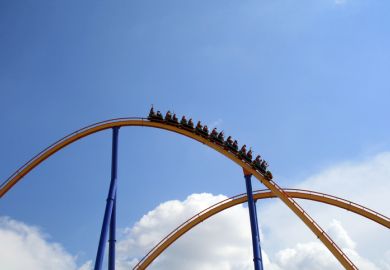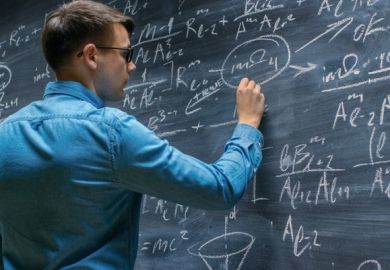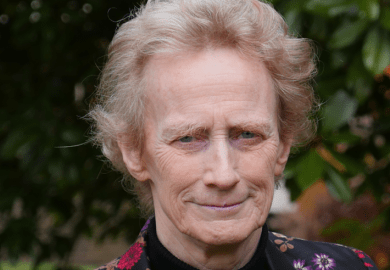Ilya Prigogine has no time for the idea that time is an illusion.
Time is our existential dimension. It has fascinated philosophers and scientists as well as poets: in ancient Greece, Heraclitus emphasised the central role of change in the universe, while Parmenides favoured a timeless universe. Probably Parmenides saw time differently after the completion of his famous poem in which he claimed that everything that now is has always existed and will forever exist. Closer to our time, Einstein stated that time is an "illusion" - by which he meant that there is no "arrow" of time in the fundamental laws of physics. Einstein did not, however, negate time, as the physicist Julian Barbour does in The End of Time .
According to Barbour, even time as a coordinate should be eliminated. He is convinced that time does not exist. It is in his favour that he emphasises in many places that his work is only at a preliminary stage. Thus his title, The End of Time: The Next Revolution , must be a speculative statement.
Barbour writes with passion and even poetry. As time is so important in life, his project, if successful, would show that our lives are an illusion. But then how to understand that humans are still able to introduce novelties in science? And if motion is an illusion, where does the illusion stop? What about the success of classical and quantum mechanics? Is science itself an illusion?
It is interesting that Barbour does not try to produce proofs but instead states qualitative arguments in favour of his approach. With great intellectual honesty, he points out that he is advocating extreme positions. For example, he refers repeatedly to the so-called Wheeler-DeWitt equation, yet notes that the equation leads to unresolved difficulties.
This equation is the usual equation for the wave function (Schrodinger equation) of the universe applied to a fixed energy value of zero. In this way, time dependence is eliminated from the Schrodinger equation. But there is a basic assumption here. Can we speak of the "wave function" of the universe? The universe is a large system with a huge number of degrees of freedom. From this viewpoint, it is similar to a thermodynamical system. Indeed the history of the universe is generally described by its temperature, a thermodynamic parameter. Since the work of Boltzmann, Gibbs and Einstein, we have known that the laws of thermodynamic systems are based not on individual trajectories or the wave functions of quantum mechanics but on statistical descriptions. The implication is that there is no Schrodinger equation for the universe and the universe should be described statistically by a time-dependent probability.
In order to restore "history", or at least the illusion of history, Barbour introduces the idea of "time capsules". "As few things delight me more than a kingfisher in flight," he writes, "this is a matter of some interest to me. The answer that suddenly came to me in the summer of 1991... was that the flight ... is ultimately an illusion, though it rests on something that is very special and just as real as we take flight to be... Now let me make an assumption in the hallowed tradition of Boltzmann: only the probable is experienced."
But if motion is an illusion, everything is an illusion. Barbour's introduction of probability is incomprehensible to me. He defines his time capsule as a static object, claims it is "any fixed pattern that creates or encodes the appearance of motion", and later adds: "What is especially striking about the Earth is the way in which it contains time capsules nested within time capsules, like a Russian doll. Individual biological cells (properly interpreted) are time capsules from which biologists read genetic time. Organs within the body are again time capsules, and contain traces of the history and morphogenesis of our bodies. The body itself is a time capsule." But this is against everything we know about life. The body is an open system full of temporal and rhythmic processes. How can it be regarded as a fixed pattern? This is completely illogical. Chrono-biology has shown that the rhythms are distributed over a large scale. The very existence of the body's structure is due to time-dependent processes.
Which brings me to another aspect of the book. Barbour asks repeatedly why our universe is so special. He writes: "I believe that in every instant we experience creation directly". How is this compatible with a static universe? Barbour ignores completely the recent advances in non-equilibrium thermodynamics. Our universe is in a highly non-equilibrium situation and has remained so since its origin. There is now agreement that, far from equilibrium, coherent structures may appear at bifurcation points. These structures define the difference between the past and the future (a question asked frequently by Barbour): in the past we followed well-defined branches after each bifurcation, whereas the bifurcations and branches of the future are not known to us. The complexity of our universe is thus an outcome of non-linear equations applied to far-from-equilibrium conditions.
Bifurcations exist also in Barbour's picture (see his figure 6). From a given "now" there arises a multiplicity of new "nows". But nothing is said by him about the mechanism of these bifurcations. In non-equilibrium physics, bifurcations are followed by regions in which a system can be described in terms of a well-defined branch. Do we have to conclude that in Barbour's picture every point corresponds to a bifurcation? There would then be an infinite number of "nows" and a continuous set of bifurcations - a sort of temporal version of the "many universes" of Hugh Everett - which leads to a strange situation close to science fiction.
There are many points in this book where I could press for greater clarification. But it is not the place to enter into further debate. Anyway, Barbour's arguments have not convinced me and often appear self-contradictory. The End of Time deals with fundamental problems, to which nobody has the complete answer. At a time when science turns mainly to applications, it is good to see a scientist so enthusiastic and even passionate about the nature of the universe. This book could stimulate interest in these fundamental problems and focus attention upon them - but it has to be treated with some healthy scepticism.
Ilya Prigogine, Nobel laureate, is director, Ilya Prigogine Center for Studies in Statistical Mechanics and Complex Systems, University of Texas at Austin.
The End of Time: The Next Revolution in our Understanding of the Universe
Author - Julian Barbour
ISBN - 0 297 81985 2
Publisher - Weidenfeld and Nicolson
Price - £20.00
Pages - 371
Register to continue
Why register?
- Registration is free and only takes a moment
- Once registered, you can read 3 articles a month
- Sign up for our newsletter
Subscribe
Or subscribe for unlimited access to:
- Unlimited access to news, views, insights & reviews
- Digital editions
- Digital access to THE’s university and college rankings analysis
Already registered or a current subscriber? Login


